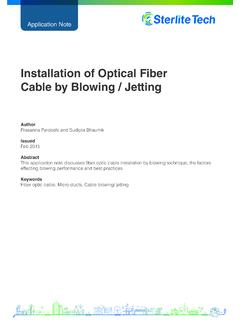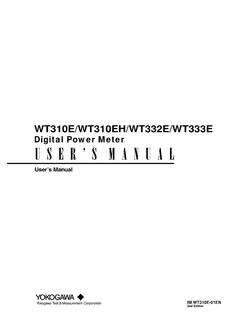Transcription of Aerial Cable Placing Procedure - STL TECH | Digital ...
1 IssuedNovember Sterlite is a registered trademark of Sterlite Technologies LimitedAbstractAn Aerial Cable is an insulated Cable usually containing all fibres required for a telecommunication line, which is suspended between utility poles or electricity pylons. Aerial optical cables are available in a variety of designs to suit every overhead application. Aerial Cables are supplied as self-supporting including non-metallic ADSS variants, figure 8 which includes an independent catenary wire or cables which can be lashed to existing overhead catenaries.
2 This document describes the most preferred methods for Aerial installation. ADSS, Fig 8, Micro ductKeywordsAerial Fiber Cable Placing MethodsApplication Note Sterlite is a registered trademark of Sterlite Technologies LimitedApplication Note 1. Table of Contents2 Introduction3 General4 Precautions Cable Handling LED and Laser Precaution Optical Fiber Handling Precautions Material Safety Safety During Installation Personal Protective Equipment Traffic Safety Placing Equipment Cable Protection and Reel Handling5 Preparation for Cable Placing Pre-Construction Survey Pre-Construction Fiber Measurements6 Unique Aspects of the Messenger Strand (Suspension Strand)
3 7 Tools and Materials8 Types of Aerial Plant Aerial Cable Lashed to a Messenger Strand Messenger Strands Moving Reel Method Stationary Reel Method Cable Lashing Self-Supporting Cable Figure-Eight Cable Dead-Ends All-Dielectric Self-Supporting (ADSS) Cable Micro-duct Cable used in Aerial plant Micro-Ducts Micro-Duct Cables Jetting: Micro-Duct Cable Placing Method Micro-Duct Cable Sterlite is a registered trademark of Sterlite Technologies LimitedApplication Note 2.
4 IntroductionThis practice covers the basic guidelines for installation of Aerial fiber-optic Cable . It is intended for personnel with prior experience in planning, engineering, or placement of Aerial Cable . Pole line construction and strand installation are not covered in this document. A working familiarity with Aerial Cable requirements, practices, and work operations is necessary as this guide does not cover all aspects of Aerial construction work. Aerial optical Cable is suspended in the air from poles and/or support structures.
5 Most often it is supported between poles by being lashed to a wire rope messenger strand with a small gauge wire. The strand is tensioned to satisfactorily withstand the weight of the Cable for the span length it will be used on plus any climatic loading such as ice, snow, and wind. The objective is to keep the Cable in as low a state of stress as possible while maintaining sag in the messenger and Cable that is safe and within limits as prescribed. Figure 1 Sterlite Duct-Lite Optical Cable for Lashed Aerial ApplicationsSome cables carry their own messenger and get their name from their shape, Figure-Eight Cables.
6 The messenger is in the top portion of the figure-eight which has an extruded over jacket. The Cable is supported from the messenger portion of the Cable with a thin plastic web. As with the lashed Cable , the messenger must be properly tensioned to resist the expected loading while keeping sag between supports safe and within acceptable limits. Figure 2 Sterlite Loose Tube Figure-Eight Optical Cable for Aerial ApplicationsThe next type of Aerial Cable is an All-Dielectric Self-Supporting (ADSS) Cable with extra aramid yarn to provide its own support, eliminating the need for a messenger strand.
7 ADSS Cable is often used to span large distances when being supported off power utility towers. It is also popular when used near power utility lines as distribution Sterlite is a registered trademark of Sterlite Technologies LimitedApplication Note The final optical Cable covered in this document is a small diameter micro-duct Cable , Micro DUCT-LITE Optical Cable . It has a cross-sectional diameter in the range from ( mm) to ( mm) for cables ranging from 12 to 288 fibers.
8 Its cross-section consists of between 1 and 24 loose buffer tubes wrapped around a dielectric central strength member (CSM). It is an all dielectric Cable so bonding and grounding issues are more relaxed. In its present configuration, it has a dry core and wet buffer tubes (filled with thixotropic water blocking gel). Figure 3 Sterlite Aerial -Lite (ADSS) Optical Cable for Aerial ApplicationsFigure 4 Cross-Section of Sterlite's Micro DUCT-LITE Multitube Fiber Optic CableAs is shown in Figure 5, a micro-duct Cable provides a more compact packing for the fiber in a Cable half the weight of a conventional optical Cable .
9 Figure 5 Comparison of Sterlite's Micro-Duct Optical Cable to a 72 Fiber Conventional Optical Sterlite is a registered trademark of Sterlite Technologies LimitedApplication Note Sub-ducts and micro-ducts are not used too frequently in Aerial installations, but they are used occasionally when the Placing operation cannot interrupt surface traffic or extra protection is required for the Cable . Micro-duct Cable is blown (jetted) into the micro-duct.
10 Normally, standard size fiber optic cables can be pulled or blown into short lengths of Aerial inner most common OSP uses of the different Aerial Cable designs are shown in Table PlantMessenger StrandMicro-DuctsCampusesUrbanNewSuburba nOldSuburbanRuralTable 1 Commonly Used Aerial Plant Types for Various OSP Applications= Used often in this application= Can be used in the application under certain circumstancesFigure 8 ADSS3. GeneralThe Aerial Placing methods described in this document are intended as guidelines. National, state, local, corporate regulations and industry recommendations normally take precedence over the procedures contained herein.








